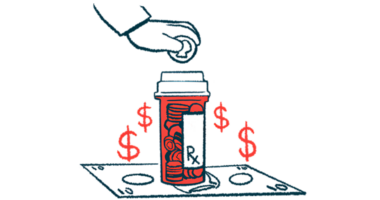#AANAM — Investigational VY-AADC01 Gene Therapy Provides Benefits for Parkinson’s Patients, Phase 1 Data Show

A single-dose infusion of VY-AADC01, an investigational gene therapy, improves motor function and reduces the need for antiparkinsonian medications in advanced Parkinson’s disease patients, results from the Phase 1 PD-1102 clinical trial show.
Trial findings were presented in a scientific poster, titled “PD-1102: A Phase 1 study of VY-AADC01 Administered Using a Posterior Approach in Patients with Parkinson’s Disease and Motor Fluctuations,” during the 2019 American Academy of Neurology (AAN) annual meeting, taking place through May 10 in Philadelphia.
VY-AADC01, a gene therapy being developed by Neurocrine Biosciences and Voyager Therapeutics, delivers the AADC gene directly into a specific brain area called the putamen, a large structure filled with dopamine receptors. This gene carries the information for the production of the L-amino acid decarboxylase (AADC) enzyme that mediates the conversion of levodopa into dopamine.
Death of dopaminergic neurons and a reduction in AADC enzyme levels are two key underlying features of Parkinson’s. The strategy of delivering the AADC enzyme into brain cells is aimed at restoring the conversion of levodopa and increasing dopamine production.
PD-1102 (NCT03065192) is an ongoing open-label Phase 1 trial evaluating the safety and efficacy of a single dose of VY-AADC01 — 9.4 × 1012 vg — injected directly into the striatum using a surgical approach in which the gene therapy is delivered through the back of the patient’s head (posterior surgical approach).
Another ongoing Phase 1b trial, called PD-1101 (NCT01973543), is evaluating the safety and efficacy of ascending doses of VY-AADC01 — 7.5 × 1011 vector genomes (vg), 1.5 and 4.7 × 1012 vg — whereby the gene therapy is injected directly into the striatum of 15 Parkinson’s patients via a surgical procedure through the top of the head (frontal surgical approach). The surgical intervention is aided by real-time magnetic resonance imaging (MRI) to monitor the gene therapy’s delivery.
Interim results of this trial reported dose-dependent improvements in motor function, patients’ quality of life, and reduction of antiparkinsonian medications.
The new neurosurgical strategy employed in the PD-1102 trial is thought to decrease the infusion time while enhancing the gene therapy’s coverage of its targeted brain area.
PD-1102’s main objectives include safety and measures of efficacy, such as coverage of the putamen brain area, AADC activity, changes in motor function and in dyskinesia (the abnormal involuntary movements that characterize advanced Parkinson’s), use of antiparkinsonian medications, and patients’ reported on and off times.
Off periods in Parkinson’s are characterized by the reappearance or worsening of symptoms — such as tremors and dyskinesia — due to a gradual decline in levodopa’s therapeutic effectiveness. These symptoms become more frequent and severe as the disease progresses.
The trial enrolled eight patients, at a mean age of 56.8 years, with advanced Parkinson’s (mean disease duration of 9.2 years) and with similar characteristics to those enrolled in the PD-1101 study.
At the start of the trial, patients’ mean off time was 6.8 hours, while the mean on time (the period when levopoda is working) was 9.1 hours.
Administration of a single dose of VY-AADC was able to cover 54% of the putamen brain area. Moreover, infusion of the gene therapy took 3.1 hours, two hours less than the time of infusion in the PD-1101 trial (5.2 hours).
Treatment with VY-AADC increased AADC enzyme activity in the putamen area by 85%, which reflects the ability of neurons to convert levodopa to dopamine.
Compared with the beginning of the study, the gene therapy improved patients’ motor function at 12 months and improved patients’ good on time (on time without troublesome dyskinesia) by 1.7 hours and reduced off time by 2.2 hours after 12 months.
The treatment also lowered patients’ use of antiparkinsonian medications by 28% six and 12 months after infusion.
Exploratory analyses in four patients with low or no dyskinesia or absence of impulse control disorder at the start of the trial showed that a single infusion of VY-AADC in this group led to greater improvements, with good on time increased by 3.2 hours and off time reduced by 3.2 hours after 12 months.
Infusions of VY-AADC were well-tolerated with no serious adverse events.
VY-AADC also improved patients’ quality of life, as measured by the 39-item Parkinson’s Disease Questionnaire, a self-administered questionnaire that addresses aspects of functioning and well-being. Patients’ mean scores decreased — or improved — by 7.6 points after 12 months.
“The results from this Phase I trial in patients with Parkinson’s disease provide further evidence that VY-AADC administration can allow neurons in the brain to convert levodopa to dopamine and improve motor function,” Eiry W. Roberts, MD, chief medical officer of Neurocrine, said in a press release.
“[These results] confirm previous data from a separate, ongoing Phase I study demonstrating that increased coverage of the putamen with VY-AADC leads to an increase in AADC enzyme activity and improvements in motor function and quality of life in patients with Parkinson’s disease — with less need for oral levodopa medication,” he added.
Based on the positive results from both the PD-1101 and PD-1102 trials, researchers have launched the RESTORE-1 Phase 2 trial (NCT03562494). The trial, currently recruiting participants, will randomize patients with advanced Parkinson’s disease who have failed to respond properly to oral therapy to either optimized medical management plus VY-AADC01 or continued optimized medical management — including levodopa — plus placebo-surgery.






